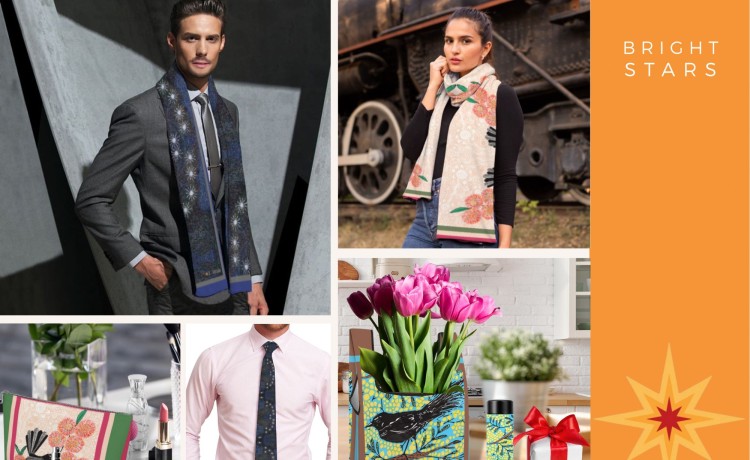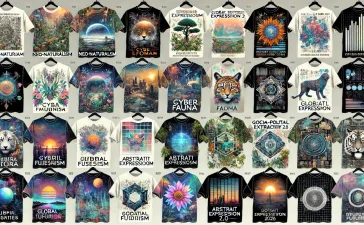Indigenenousr artist : Julianne Wade as Whadjuk artist
Julianne Wade Website: https://juliannewadewhadjukartist.com.au/
Licensing Artist page: https://artshinelicensing.com/artists/julianne-wade/
In the ever-evolving world of corporate gifting, a powerful trend has emerged: incorporating cultural and indigenous art into custom products. This shift not only adds a unique touch to corporate gifts but also allows companies to express their values, support local communities, and create meaningful connections with their clients and employees. For corporate gift production companies, particularly those specializing in custom printing and products, this trend opens up a world of creative possibilities and business opportunities.
The Rise of Indigenous Art in Corporate Gifting
Australia: Leading the Way
Australia has been at the forefront of this movement, with a significant focus on incorporating Indigenous art into corporate gifts. This trend reflects a growing national recognition of Indigenous culture and a desire to promote reconciliation and respect.
Key Aspects:
- Collaboration with Indigenous artists to create unique designs
- Use of traditional symbols and storytelling in modern corporate contexts
- Products ranging from custom-printed stationery to high-end art pieces
Example: A major Australian bank commissioned Indigenous artists to create designs for their corporate credit cards, showcasing Indigenous art to millions of customers daily.
Global Perspectives
While Australia has been a leader in this trend, other countries are also embracing their indigenous and cultural art in corporate gifting:
- New Zealand: Maori art and designs are increasingly popular in corporate gifts, reflecting the country’s bicultural heritage.
- Canada: First Nations, Inuit, and Métis art is being integrated into corporate products, celebrating the country’s indigenous cultures.
- South Africa: Corporate gifts featuring traditional African patterns and Zulu beadwork are gaining popularity, reflecting the country’s rich cultural diversity.
- United States: Native American-inspired designs are being used in corporate gifts, especially in regions with strong indigenous heritage.
- Japan: Traditional arts like calligraphy and woodblock printing are being reimagined for corporate gifts, blending modern corporate needs with centuries-old artistic traditions.
The Appeal of Cultural Art in Corporate Gifting
- Uniqueness and Memorability Cultural and indigenous art offers unique designs that stand out in a sea of generic corporate gifts. These pieces become memorable tokens that recipients are likely to display and cherish.
- Brand Alignment with Social Responsibility By incorporating indigenous art, companies demonstrate their commitment to cultural appreciation and social responsibility, aligning their brand with positive values.
- Storytelling Opportunities Each piece of cultural art tells a story, providing companies with rich narratives to share with their clients and stakeholders, deepening the emotional connection to the brand.
- Support for Local Communities Collaborating with indigenous and local artists provides economic opportunities for often marginalized communities, showcasing a company’s commitment to social impact.
- Global Appeal with Local Touch For international companies, using different cultural art styles in various regions allows for a globally consistent yet locally relevant gifting strategy.
Opportunities for Corporate Gift Producers
For companies specializing in custom corporate products, this trend presents several opportunities:
- Expanded Product Lines Develop new product lines that incorporate cultural and indigenous art, such as:
- Custom-printed mousepads with indigenous designs
- Notebooks featuring cultural patterns on covers
- USB drives with etched cultural motifs
- Corporate apparel with subtle indigenous art elements
- Collaborative Partnerships Establish partnerships with local artists and indigenous art organizations to ensure authentic and respectful use of cultural designs.
- Collaboration with Art Licensing Agencies Partner with reputable art licensing agencies like ArtSHINE, who represent a diverse range of artists, including indigenous artists. These agencies can:
- Help find artists whose style aligns with specific corporate projects
- Ensure proper licensing and fair compensation for artists
- Provide a wide selection of high-quality, commercially viable artworks
- Offer expertise in adapting artworks for various products and mediums
- Handle legal and administrative aspects of artist collaborations
- Provide background information on artists and their work for storytelling purposes
- Educational Marketing Create marketing materials that educate corporate clients about the significance of the art and artists, adding value to the gifting experience.
- Customization Services Offer services to adapt cultural art to fit specific brand colors and styles, ensuring harmony between the art and corporate identity.
- Sustainability Focus Combine cultural art with eco-friendly materials, appealing to companies’ sustainability goals.
Best Practices for Incorporating Cultural Art
- Respect and Authentication Ensure all designs are created in collaboration with or licensed from indigenous artists. Avoid cultural appropriation by giving proper credit and compensation.
- Cultural Sensitivity Provide cultural context and meaning behind the designs to prevent misuse or misinterpretation.
- Quality and Authenticity Maintain high production standards to honor the original artwork and ensure the final product does justice to the cultural significance of the designs.
- Ethical Sourcing Implement transparent supply chains and fair compensation models for artists and communities involved.
- Storytelling Develop compelling narratives around each product, explaining the art’s origin, meaning, and the collaboration process.
Challenges and Considerations
- Balancing Tradition and Corporate Needs Find ways to respectfully adapt traditional designs to suit modern corporate aesthetics without losing their cultural essence.
- Scalability Develop processes to scale production while maintaining the uniqueness and quality of each piece.
- Copyright and Intellectual Property Navigate the complex landscape of cultural copyright, ensuring proper licensing and respect for traditional knowledge.
- Cultural Variations Be aware of the diversity within indigenous cultures and avoid generalizations or stereotypes in design choices.
The Future of Cultural Art in Corporate Gifting
As companies increasingly seek to express their values and create meaningful connections through their branding and gifting strategies, the incorporation of cultural and indigenous art is likely to grow. This trend not only offers a way for businesses to stand out but also promotes cultural appreciation and supports indigenous communities.
For corporate gift production companies, staying ahead of this trend means:
- Continuously educating themselves about various cultural art forms
- Building strong, ethical relationships with indigenous artists and communities
- Investing in technologies that can faithfully reproduce intricate cultural designs
- Developing marketing strategies that highlight the unique value of cultural art in corporate gifting
By embracing this trend, corporate gift producers can position themselves at the forefront of a movement that goes beyond mere product creation. They become facilitators of cultural appreciation, supporters of indigenous artistry, and partners in corporate social responsibility efforts.
In conclusion, the integration of cultural and indigenous art into corporate gifting represents a significant opportunity for gift production companies to innovate, differentiate their offerings, and contribute to cultural preservation and appreciation. As this trend continues to grow globally, those who can authentically and respectfully incorporate these rich artistic traditions into their products will find themselves well-positioned in the evolving corporate gifting landscape.
- Find out more
- Launch Pad + Accelerator Expressions of Interest
- Selling and Licensing Your Art & Designs Around the World with ArtSHINE.
- Looking for exciting new Art and Designs to license.
We’re here to help you to take action, just like we’ve helped thousands of other entrepreneurs, business owners, and creative professionals all around the globe.
Now is the time to let your passion SHINE.
Now is the time to Make Tomorrow Today!
To your success, Vinh Van Lam and Stuart Horrex Cofounders ArtSHINE.com





